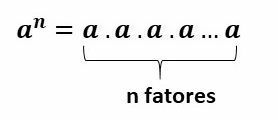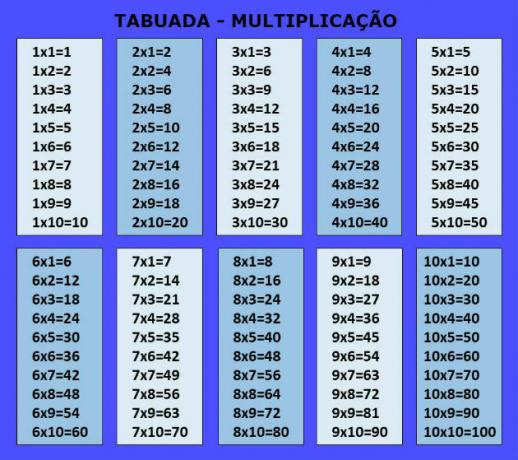Division is a mathematical operation used to discover how to separate a quantity into parts, that is, "fraction" something.
Generally, the symbol used for the operation is , but we can also find cases where: and / are used as a division sign.
For example, we can indicate a simple division as follows:
31 = 3
4: 2 = 2
5 / 5 = 1
the terms of the division
The term names of a division are: dividend, divisor, quotient, and remainder. See the example below.
Therefore, we can write the split account as follows:
dividend divisor = quotient
14 2 = 7
Note that in the division of 14 by 2 we get an exact division, as there is no remainder.
Exact division is the inverse operation of multiplication, as the multiplication of quotient and divisor results in the dividend.
quotient x divisor = dividend
7 x 2 = 14
If a division has a remainder then it is classified as not exact. For example, the division of 37 by 15 is not exact, as it has a remainder other than 0.
In this way, we can relate the terms of the division as follows:
quotient x divisor + remainder = dividend
2 x 15 + 7 = 37
Know what the dividers.
How to account for splitting
Check out some examples of division and the rules for performing this mathematical operation.
whole number division
The rules for dividing whole numbers are:
1st: organize the operation by identifying the dividend and the divisor;
2nd: find a number that multiplied by the divisor is equal to or close to the dividend;
3rd if the number is less than the dividend, subtract one for the other and continue the division with the rest until there is no more number to continue the division.
Example: 224 8
Since we get to the remainder 0, we have an exact division. Note that 224 is divisible by 8, since 28 x 8 = 224.
Also read about multiples and divisors.
Division with decimal numbers (comma division)
When the division is not exact, we can continue performing the operation with the remainder, but we will get a decimal quotient.
For that, we add a 0 to the remainder to continue the division and we must put a comma in the quotient to continue the operation.
Example: 31 5
Therefore, 31:5 is a division with a decimal quotient.
In the division where the dividend and the divisor are decimal, we must start by eliminating the decimal point from the divisor. To do this, we count the number of places after the decimal point and "walk" the same number of places in the dividend.
Example: 2.5 0,25
Note that the divisor after the comma has two digits. So we move the decimal point two places in the divisor and the dividend. So 2.5 0.25 turns into 250
25, that is, it's like multiplying the two numbers by 100.
So 2.5 0,25 = 250
25 = 10.
Learn more about comma division.
Division of numbers with different signs
When dividing numbers with different signs we must take into account the rule of signs to determine the result.
| first sign | second sign | result sign |
|---|---|---|
| + | + | + |
| – | – | + |
| + | – | – |
| – | + | – |
For this type of division we have the rules:
- Division of two positive numbers yields a positive result;
- Division of two negative numbers yields a positive result;
- Dividing numbers with different signs yields a negative result.
Check out some examples:
22 11 = 2
(– 10) (– 5) = 2
30 (– 15) = – 2
(– 40) 20 = – 2
Don't forget that when a number is positive (+) you don't need to put the sign before it.
See too: multiplication tables
division of fractions
Before we start, let's name the terms of a fraction with the following example.
To perform the division of fractions, we follow the rules:
1st: The numerator of the first fraction multiplies the denominator of the second and the result is in the numerator of the answer;
2nd: The denominator of the first fraction multiplies the numerator of the second and the result is in the denominator of the answer.
Example:
This rule applies regardless of the number of fractions. Look:
know more about multiplication and division of fractions.
Division properties
Property I: the division is not commutative.
For example:
4: 2 = 2
2: 4 = 0,5
Therefore, 4: 2 ≠ 2: 4.
Property II: the division is not associative.
For example:
(40: 4): 2 = 10: 2 = 5
40: (4: 2) = 40: 2 = 20
Therefore, (40: 4): 2 ≠ 40: (4: 2)
Property III: the division quotient is the same for multiples of the dividend and the divisor.
For example:
6: 2 = 3
(6 x 3): (2 x 3) = 18: 6 = 3
Therefore, if we multiply the dividend and the divisor by a number other than 0, the quotient of the division remains the same.
Property IV: the division by 0 is undefined and when the dividend is 0 the result of the division is 0.
For example:
6: 0 has no result in real numbers
0: 6 = 0
Property V: every number divided by 1 results in the number itself. When the dividend and the divisor are the same number, the quotient is 1.
For example:
8: 1 = 8
8: 8 = 1
Also read about Maximum Common Divider - MDC and divisibility criteria.
division exercises
question 1
Perform the following divisions.
a) 200 5
b) (-40) 8
ç)
Correct answer: a) 40, b) – 5 and c) 3/4.
a) 200 5
Therefore, 200 5 = 40
b) (– 40) 8
Dividing 40 by 8 results in 5. However, we need to play the signs game, as the numbers have different signs. Since the first sign is negative (–40) and the second sign is positive (+8), then the result is negative (–5).
Therefore, (– 40) 8 = – 5.
ç)
Therefore, 1/2 2/3 = 3/4.
question 2
Ana, Paula and Carla went to dinner at a restaurant and the bill was R$63.00. If they split the expenses equally, how much did they each pay?
a) BRL 23.00
b) BRL 21.00
c) BRL 26.00
Correct answer: b) R$ 21.00.
Therefore, each one paid R$ 21.00.
question 3
John wants to split a 31-meter rope into four equal parts. How long is each part?
a) 12 meters
b) 0.92 meters
c) 7.75 meters
Correct answer: c) 7.75 meters.
According to the data in statement 31 is the dividend and 4 is the divisor. Therefore, we set up the division as follows:
Note that 7 is the number that multiplied by 4 most closely approximates 31, since 7 x 4 = 28. Therefore, the division quotient is 7.
In the division above we have the remainder 3. To continue the operation we put a 0 next to the 3 and add a comma to the quotient.
Since we haven't yet arrived at an exact division, we can add another digit to continue the division, but we don't need another comma in the quotient.
We arrived at an exact division and, therefore, we can say that the 31 meter rope was divided into 4 equal parts of 7.75 meters.
Keep practicing with the Division Exercises.



